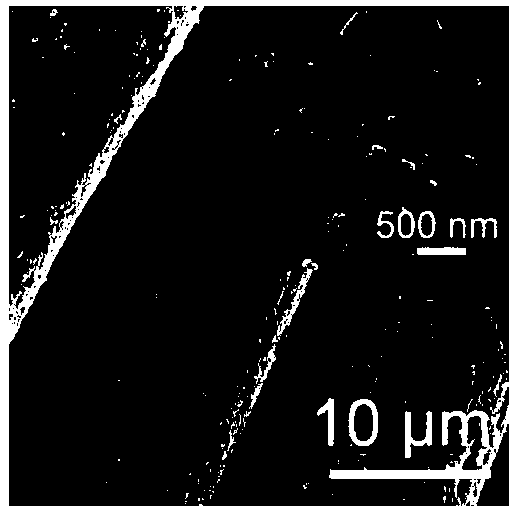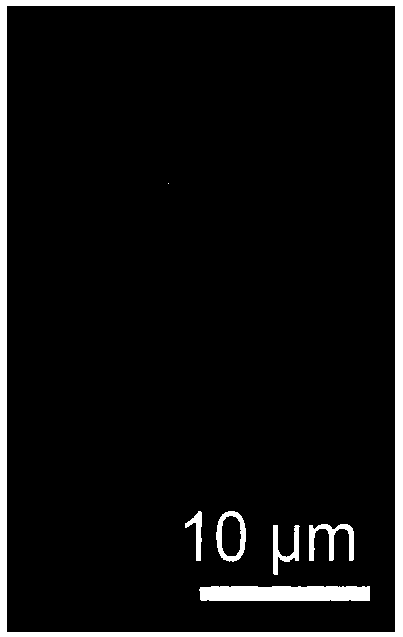Fluorosilicone resin based on click chemistry and preparation method of self-repairing superhydrophobic coating
A super-hydrophobic coating, fluorosilicone resin technology, used in coatings, polyurea/polyurethane coatings, devices for coating liquids on surfaces, etc., can solve the problems of etching loss, short repair cycle, and long repair time , to achieve high mechanical strength and overcome the effect of long migration time
- Summary
- Abstract
- Description
- Claims
- Application Information
AI Technical Summary
Problems solved by technology
Method used
Image
Examples
Embodiment 1
[0029] Embodiment 1: PET fiber substrate
[0030] (1) Surface pretreatment: Put the PET fiber substrate into an ethanol solution for ultrasonic cleaning, remove impurities such as grease and dust on the surface, use an ethanol solution with a mass concentration of 80%, take it out and dry it naturally;
[0031] (2) Primer solution configuration: ultrasonically disperse 10 g of fluorinated silica nanoparticles and 5 g of two-component polyurethane adhesive in 30 g of acetone to obtain a polyurethane composite primer solution;
[0032] (3) Topcoat solution configuration: blend 5g of multifunctional fluorosilicone resin and 0.25g of butyl titanate curing agent into 50g of acetone to obtain fluorosilicone resin topcoat solution; wherein the multifunctional fluorosilicone resin preparation step As follows: under nitrogen protection, add 1mol pentaerythritol tetramercapto propionate, 2mol methacrylmethoxysilane, 2mol perfluorooctyl ethyl acrylate and 0.01mol triphenylphosphine alkal...
Embodiment 2
[0036] Embodiment 2: aluminum alloy base material
[0037] (1) Surface pretreatment: Use sandpaper to quickly polish the surface of the aluminum substrate, then put it into an ethanol solution for ultrasonic cleaning, remove surface grease, dust and other impurities, use an ethanol solution with a mass concentration of 80%, take it out and dry it naturally ;
[0038] (2) Primer solution configuration: ultrasonically disperse 10 g of fluorinated titanium dioxide nanoparticles and 10 g of polyurethane adhesive in 100 g of N,N-dimethylacetamide to obtain a polyurethane composite primer solution;
[0039] (3) Topcoat solution configuration: blend 5g of multifunctional fluorosilicone resin and 0.5g of stannous octoate curing agent in 100g of acetone to obtain fluorosilicone resin topcoat solution; wherein the preparation steps of the multifunctional fluorosilicone resin are as follows : Under nitrogen protection, add 1mol dipentaerythritol hexamercaptopropionate, 3mol methacrylmet...
Embodiment 3
[0043] Example 3: Glass substrate
[0044] (1) Surface pretreatment: put the glass base material into an ethanol solution for ultrasonic cleaning, remove impurities such as grease and dust on the surface, use an ethanol solution with a mass concentration of 80%, take it out and dry it naturally;
[0045] (2) ultrasonically disperse 10 g of fluorinated kaolin micro-nano particles and 5 g of polyurethane adhesive in 50 g of N,N-methylpyrrolidone to obtain a polyurethane composite primer solution;
[0046] (3) Topcoat solution configuration: Blend 5g of multifunctional fluorosilicone resin and 0.35g of γ-aminopropyltriethoxysilane curing agent with 100g of acetone to obtain a fluorine-containing silicone resin topcoat solution; The preparation steps of fluorosilicone resin are as follows: under nitrogen protection, 1mol isocyanuric acid trimercapto carboxylate, 2mol methacryloylmethoxysilane, 1mol perfluorooctyl ethyl acrylate and 0.0075mol Triethylenetetramine base catalyst, ca...
PUM
| Property | Measurement | Unit |
|---|---|---|
| Roll angle | aaaaa | aaaaa |
| Roll angle | aaaaa | aaaaa |
| Roll angle | aaaaa | aaaaa |
Abstract
Description
Claims
Application Information
 Login to View More
Login to View More - R&D
- Intellectual Property
- Life Sciences
- Materials
- Tech Scout
- Unparalleled Data Quality
- Higher Quality Content
- 60% Fewer Hallucinations
Browse by: Latest US Patents, China's latest patents, Technical Efficacy Thesaurus, Application Domain, Technology Topic, Popular Technical Reports.
© 2025 PatSnap. All rights reserved.Legal|Privacy policy|Modern Slavery Act Transparency Statement|Sitemap|About US| Contact US: help@patsnap.com



